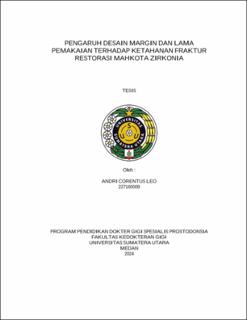| dc.description.abstract | Zirconia was suggested as the first candidate for monolithic restorations due to its
significant advantages, such as excellent mechanical properties, superior to other ceramic systems,
good aesthetics, radiocapacity, low corrosion potential, good chemical properties, volumetric
stability and has a modulus elasticity value comparable to steel. However, fractures remain a
complication of all ceramic restoration in daily practice. Margin design is a very important factor
in determining the strength of an all-ceramic crown. The marginal area of the zirconia crown is an
area with minimal thickness that often causes the crown to be easily fractured. Shoulder and
chamfer are recommended designs to obtain maximum fracture resistance from zirconia
restoration. Several studies have shown different results regarding to the effect of margin shoulder
and chamfer design on the fracture resistance of the zirconia crown. The fracture resistance and
other mechanical properties of zirconia crowns will decrease over time due to conditions inside
the oral cavity. This decrease in fracture resistance and mechanical properties is caused by a
phenomenon called aging. Study on the effect of margin design and aging simulation in the oral
cavity using accelerated aging on the fracture resistance of zirconia crown restoration is still not
much, therefore researchers are interested in analyzing the influence of margin design and length
of use on the resistance of zirconia crown fracture. This study evaluated the effect of aging
simulation using the hydrothermal aging autoclave method for 100 and 200 minutes describing 5
and 10 years of wear in the oral cavity as well as the effect of margin design on the fracture
resistance of zirconia crown restoration. The research design was a post test only control group
design. Each group has 4 samples. The sample for the margin chamfer design was prepared with
a size of 1 mm, then another group with a margin shoulder with a size of 1 mm. Both designs have
an axial surface height of 5.5 mm with a convergence angle of 60 and have a rounded occlusal
shape with a diameter of 6.0 mm. The samples were divided into control groups, 5 years and 10
years aging simulation groups. Fracture resistance testing is carried out using a universal testing
machine. This study obtained the results of margin design effect on fracture resistance with 5
years or 10 years aging simulation, with a value of p = 0.001 (p<0.05). In the group of aging
simulation effect on the fracture resistance of zirconia crowns with a margin shoulder design
showed a significant effect between the value of fracture resistance in the control groups, aging
simulation of 5 years group and 10 years group with a value of p = 0.001 (p<0.05). In the group of
the aging simulation effect on the fracture resistance of the zirconia crown with a chamfer margin
design showed a significant effect between the value of fracture resistance in the control groups,
aging simulation of 5 years group and 10 years group with a value of p = 0.043 (p<0.05). Based
on this study, the author concludes that zirconia crowns with a content of 4Y-TZP (yttrium of 4
mol%) with a chamfer margin design have higher fracture resistance when used for 5 or 10 years.
However, further research is still needed before it is applied in the clinic. | en_US |


